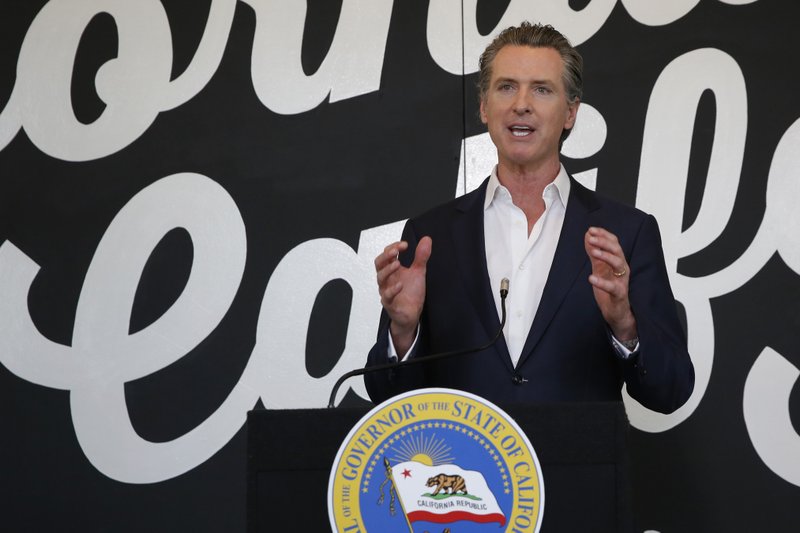SACRAMENTO, Calif. -- California will have a budget shortfall of $54.3 billion because of the economic devastation wrought by the coronavirus, Gov. Gavin Newsom's administration announced Thursday, a deficit so large it will swallow the state's reserves and put teacher jobs and health coverage at risk during a pandemic.
The state has been under a mandatory stay-at-home order since mid-March, forcing nonessential businesses to close and prompting more than 4 million Californians to file for unemployment benefits. After record low unemployment of 3.9% at the start of the year, the Newsom administration now predicts a jobless rate of 18% for the nation's most populous state -- 46% higher than the height of the last recession a decade ago.
Newsom asked the Trump administration for help, saying that although the state has the fifth-largest economy in the world the "revenue shortfalls are bigger than even the state of California." The state is already in line to receive more than $26 billion in federal aid because of the coronavirus, according to an analysis by the nonpartisan Legislative Analyst's Office. But Newsom was clear the state needs more.
"We cannot do it alone," he said.
[CORONAVIRUS: Click here for our complete coverage » arkansasonline.com/coronavirus]
It's not clear what state programs will be cut or by how much. Newsom will reveal his new spending plan next week. But the revenue shortfall means the minimum amount of spending required for public schools and community colleges will fall by $18.3 billion.
State funding accounts for 80% of most school district budgets, which are mostly spent on teacher and staff salaries, said Troy Flint, spokesman for the California Association of School Boards. He said the shortfall will "have a devastating impact on school staffing levels."
California lawmakers have been saving money for the next economic downturn to try to avoid a repeat of cuts to state services during the last recession. Since then, the state has had an unprecedented run of economic growth, adding more than 3.4 million new jobs.
That led to increased state spending and huge budget surpluses in recent years, pushing the state's "rainy day fund" to more than $16 billion. But the projected budget shortfall announced Thursday is nearly 3½ times that number, dispelling any notion of a quick recovery once the state's coronavirus restrictions are lifted.
[Video not showing up above? Click here to watch » https://www.youtube.com/watch?v=N-9l2WpiAt8]
The Newsom administration estimates state general fund revenue will decline by $41.2 billion compared with the $222.2 billion spending proposal Newsom revealed in January. Another $6 billion in anticipated emergency spending on the coronavirus for things like protective gear, hotel rooms for the homeless and cash payments for low-income adults living in the country illegally pushes the projected deficit past $54 billion.
Plus, California must pay for an extra $7.1 billion for increased enrollment in social safety net programs, including Medicaid, the joint state and federal health insurance program for the poor and disabled. Advocates worried Thursday that the deficit could mean cuts for other social service programs, including subsidies to help middle and lower income earners pay their monthly health insurance premiums.
OKLAHOMA PLANNING
In Oklahoma, the House and Senate have begun passing a package of bills that make up the state's $7.7 billion planned budget.
Lawmakers have about $1.3 billion less than anticipated in February.
The budget agreement was reached without the involvement of Gov. Kevin Stitt's staff. The governor said Wednesday that he's reviewing the proposal.
Revenue collections in Oklahoma fell by half a billion dollars in April from a year ago, Treasurer Randy McDaniel said Thursday.
Gross receipts fell $502.5 million to just under $1.1 billion, down 31.8% from April 2019, McDaniel said.
Gross production taxes on the sale of oil and natural gas totaled $60.7 million, down $19.1 million, or 24%, from last April, and do not reflect the impact of plunging oil prices because collections are based on February sales when oil was more than $50 per barrel.
In Missouri, lawmakers on Thursday agreed to try to spare colleges and universities from budget cuts despite plummeting revenue that the state budget director says are unlike anything he's ever seen.
Budget Director Dan Haug on Thursday announced net revenue collections dropped more than 54% in April this year compared with April 2019, largely because Tax Day was delayed until July. Overall state revenue decreased more than 6% so far this year compared with the same time last year.
"This is unlike anything I have ever seen," Haug said. "I couldn't even imagine revenues dropping as much as they did. To see the economy turned off like a faucet is incredible."
A Section on 05/08/2020
